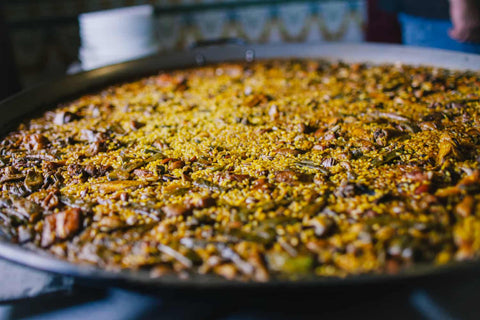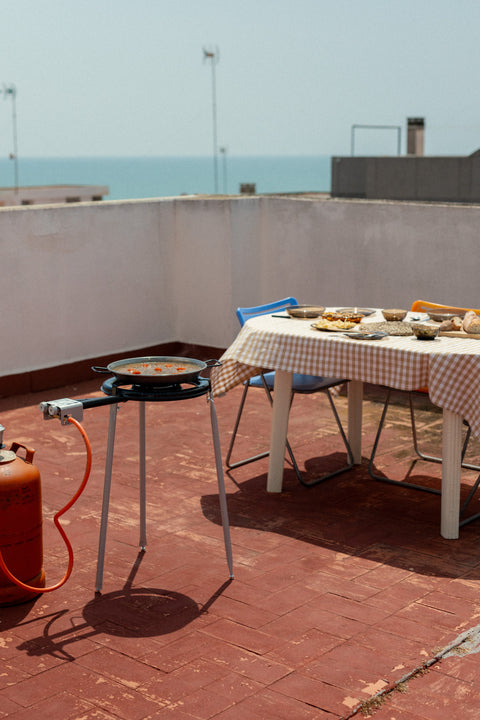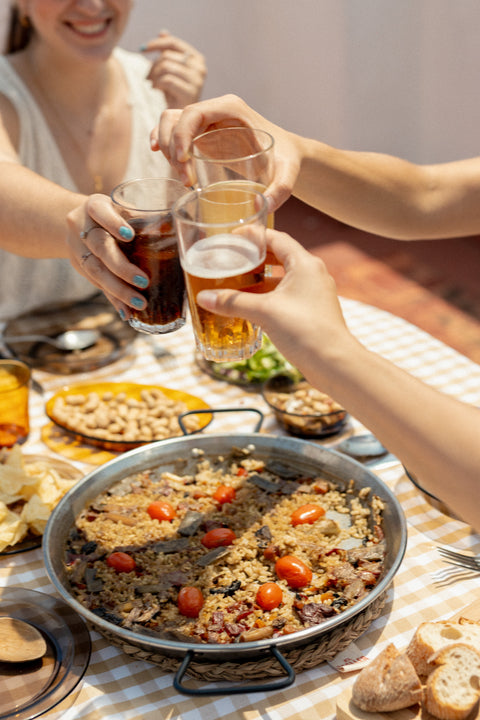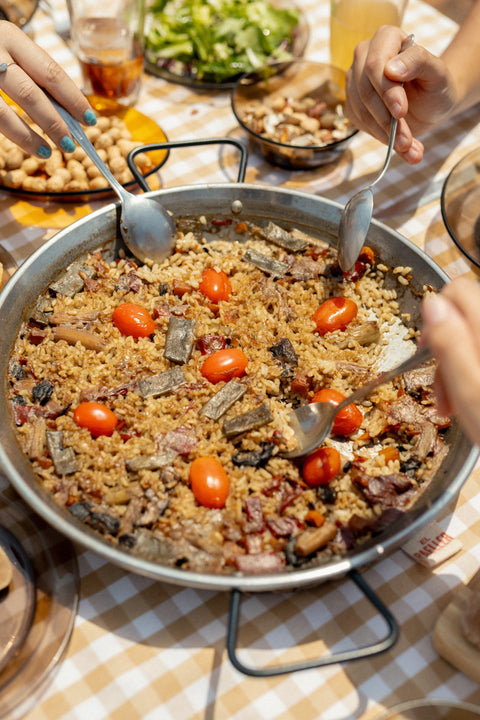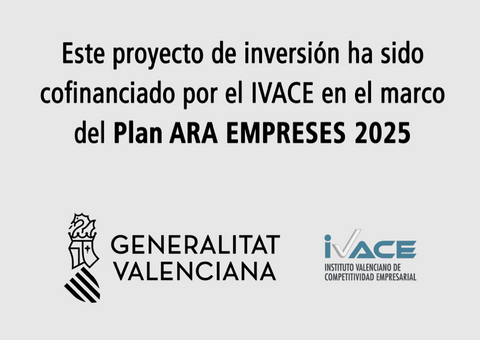Have you ever wondered why the paella you make at home doesn't taste the same as the one from your favorite restaurant? Well, the answer lies in the utensil you use. Yes, that large, shallow pan that seems so simple, but is actually the heart of this famous Spanish dish.
But before we begin, let's clarify something important: in Valencia, the pan used to cook this dish is also called a "paella." The name of the pan is the same as the name of the dish. In other areas, it's more common to call it a "paellera." Both are correct, but for clarity, in this guide we'll use the term "paellera" to refer to the pan, and "paella" to refer to the dish. So, what is a paeller? In Valencia, we use the term "paeller" to refer to the person who cooks the paella.
The importance of choosing the right paella pan
A paella pan isn't just a kitchen utensil; it's the tool that transforms simple ingredients into an iconic dish. A good paella pan ensures that the rice cooks evenly, that the socarrat (that crispy layer at the bottom) is perfect, and that the flavors blend harmoniously. Furthermore, a quality paella pan will last for many years, making it a wise investment in the long run.
Different types of paella pans And which one is best for you?
Polished steel paella pans
The polished steel paella pans These are the most traditional pans, the ones that have been used for generations in Valencia, the birthplace of paella. This material is lightweight, distributes heat evenly, and is ideal for achieving the perfect socarrat (the crispy bottom layer). They are also very durable if properly cared for.
However, it's worth mentioning that this type of paella pan requires a seasoning process after use to prevent rusting, which can be a bit laborious for some. But if you're a paella purist and like to follow traditional recipes, then this step won't be a problem for you. In fact, if you have visited any of the temples of paella such as Casa Carmela, Bairetas or l'Alter, you will have noticed that they use this type of paella pan, following the Valencian tradition.
Enameled steel paella pans
Enameled steel paella pans are a more modern and practical version of the traditional ones. The enamel coating prevents the metal from rusting, so they don't require seasoning. They are also easier to clean and maintain.
However, it's not all sunshine and roses, and the enamel can slightly affect heat distribution, so you might not achieve as perfect a socarrat as with a polished steel paella pan. Even so, if you're looking for a paella pan that's easy to use and maintain, and you don't mind sacrificing a bit of tradition, this could be a great option.
Stainless steel paella pans
Next up are stainless steel paella pans, known for their durability and corrosion resistance. They're ideal for those looking for a low-maintenance pan that can be used on various cooktops, including induction. However, stainless steel doesn't distribute heat as evenly as polished steel, which can affect the final result of your paella. One crucial aspect to consider when using stainless steel paella pans is their maintenance. After each use, thoroughly dry them—we even recommend using two drying cloths if necessary—until all traces of moisture are gone. This is the only way to prevent rust.
Cast iron paella pans
Cast iron paella pans are known for their heat retention, making them ideal for slow cooking. They are extremely durable, but they are also quite heavy and require seasoning to prevent rust. Additionally, they are not compatible with all heat sources, such as induction.
Electric paella pans
And finally, there are electric paella pans. These are another modern and convenient option, especially for those without access to a gas or wood-burning stove. The good thing is that they are easy to use and clean, and many come with temperature controls to ensure the paella cooks evenly. The only downside is that they don't offer the same authentic flavor as traditional paella pans.

What type of paella pan should you choose depending on the heat source?
Paella pans for gas stoves
The best paella pans for gas These are undoubtedly the ones made of polished or enameled steel, since they distribute heat evenly and are compatible with this type of stove. Furthermore, they are easy to handle and clean.
Best paella pan for wood fire
For cooking over a wood fire, cast iron or polished steel paella pans are highly recommended. They retain heat well and are durable enough to withstand direct flames. Just make sure the paella pan is large enough for the fire you'll be using.
Paella pans for induction
If you have an induction cooktop, stainless steel or cast iron paella pans are best. Just make sure the pan has a flat, thick bottom to work properly with this type of cooktop.
Oven-safe paella pans
And if you plan to use your paella pan in the oven, stainless steel or cast iron are best. But before buying one made of these materials, make sure the handle is heat-resistant or at least detachable to prevent accidents.
Key factors for choosing a quality paella pan
For choose a quality paella panThere are several factors you should consider. These include:
- Height: A paella pan should have a low height, between 4 and 6 cm, so that the rice cooks in a thin and even layer.
- Material: Make sure it is high quality and compatible with your heat source.
- Size: Choose the diameter according to the number of people you will be serving and the size of your heat source.
- Base type: The base should be flat for ceramic hobs and convex for wood or gas hobs.
- Cost: Adjust your choice to your budget and the use you will give it.
Which is the best paella pan for you?
The best paella pan for you will depend on your needs and preferences. So, whichever one you choose, the important thing is that you enjoy the process of cooking and sharing a delicious paella with your loved ones.
And if you're looking for a quality paella panAt El Paeller, we have a wide selection of enamelled paella pans and of polished iron paella pans to adapt to all tastes and needs.We assure you it will be a worthwhile investment!
